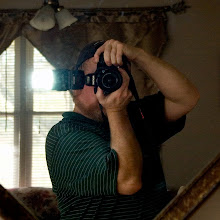Water Fowl on the pond at Matthews Park in Monroe, GA
1 February 2010
I'm just beginning to learn this art of blogging. My last attempt ran a bit long both for the genre and the attention span of the vast majority of my potential audience. So, following the advice of one of my readers (thanks Jezz :-) I'll be reworking that material in order to make it more useful in this format. In the near future, I'll be posting this reworked material as a three part series of blogs on the three basic exposure controls: aperture, shutter speed and ISO. For the moment, however, I'd like to turn to a matter of a more philosophical nature.
How do we describe the process through which we begin the creation of a photograph? What do we say we are doing when we make a "capture?" The most common phrase would be "taking a picture." There is a distinction one can make, however, between "taking" pictures and "making" photographs." "Taking" a picture can imply that the image is somewhere out there and we just have to be smart enough or lucky enough to find it. "Taking pictures" evokes visions of a relative making snapshots at the family barbecue. It can be thought of as a hit or miss affair owing more to chance than skill or artistic intention.
This isn't to say that "capturing" an image has to be hit or miss. Capturing the decisive, "Cartier-Bresson", moment is full of artistic intention. There is an element of chance, but not an overwhelming one. As Susan Sontag writes in her collection of essays, On Photography, photography is the ultimate way for our conscious to utilize its "acquisitive mode." The photographic artist is "taking" something see finds in her world, but she isn't merely "taking" something. There is more to it than that.
Real photographers "make photographs." Making photographs can be seen as the conscious effort to create a work of art by "writing with light." The key element here is artistic intent. While the capacity of our memory cards has made the necessity of previsulization a thing of the past, it is still useful as a part of the creative process and the serious artist doesn't just wonder around hoping a photograph will happen. You must put yourself in the right place at the right time and have the skill at setting the best exposure that can only come through lots and lots of practice. When you posses this skill and you are able to be at just the right spot at just the right moment, ever once in awhile divine providence will shine down upon you and you'll have the opportunity to create a uniquely captivating work of art. That's the moment the fine art photographer lives for and it is one of the sweetest feelings I've known.
For more information on Henri Cartier-Bresson, the Wikipedia article is [here]. The article on Susan Sontag is [here].
Al Williams


Image Editing software’s permit to alter or make images or digital pictures. Several bulks Image Editing Software and batch image converter supports all admired image format like JPG, PNG, BMP, GIF etc.
ReplyDelete